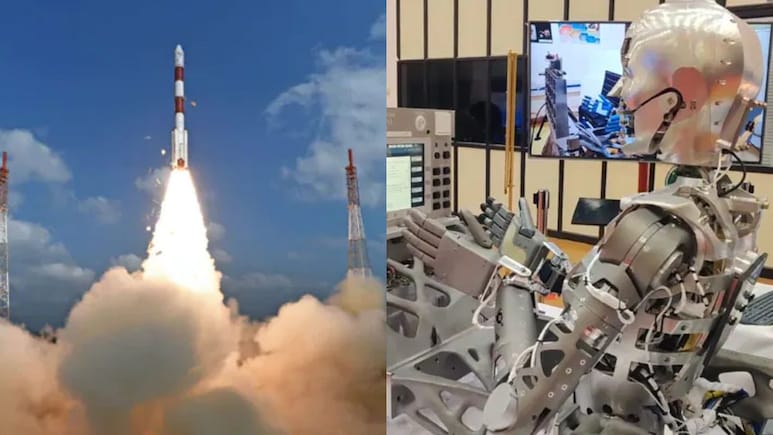
- ISRO plans nine rocket launches in 2025, including the first uncrewed Gaganyaan mission in December
- The uncrewed Gaganyaan mission will carry Vyomitra, a humanoid robot simulating human responses
- PSLV N1 rocket, built by HAL and L&T, will launch a technology demo satellite with new innovations
After the remarkable success of astronaut Group Captain Shubhanshu Shukla's 18-day mission to the International Space Station, the Indian space agency has a busy year ahead. Currently, it is gathering momentum to celebrate the second National Space Day on August 23 at Bharat Mandapam.
In a landmark year for India's space program, the Indian Space Research Organisation (ISRO) is gearing up for an ambitious slate of missions that will redefine the country's position in global space exploration. Speaking exclusively to NDTV, V Narayanan, Chairman of ISRO, outlined a packed schedule that includes nine rocket launches, the rollout of industry-built launch vehicles, and the first uncrewed mission under the Gaganyaan human spaceflight program.
"This year is declared as the Gaganyaan year," said Mr Narayanan. "We will have the first uncrewed mission by this year, December. That is what the target is. A robot will go. And, you know, Honourable Prime Minister has rolled out the space sector reform. Based on that, we have assigned five rockets to the industrial consortium of Hindustan Aeronautics Limited (HAL) and L&T Corporation."
The uncrewed Gaganyaan mission, scheduled for December 2025, will carry Vyomitra, a humanoid robot designed to simulate human responses in space. This mission marks a critical milestone in India's journey toward sending astronauts into orbit, with two additional uncrewed missions planned for next year and a crewed mission targeted for the first quarter of 2027.
"The G1, first uncrewed mission, we have targeted this December, that is on track," Mr Narayanan confirmed. "And then, followed by two uncrewed missions next year, depending on how it does, followed by the crewed mission in the first quarter of 2027."
In addition to Gaganyaan, ISRO is rolling out the Polar Satellite Launch Vehicle (PSLV N1) rocket, the first launch vehicle built entirely by the Indian industry under the new space sector reforms. Developed by Hindustan Aeronautics Limited (HAL) and Larsen & Toubro (L&T), the N1 rocket will carry a technology demonstration satellite featuring cutting-edge innovations.
"The first rocket is going to roll out, called N1 rocket, the PSLV N1 rocket," said Mr Narayanan. "In that, we are going to launch a technologically advanced demonstration satellite in which we are going to demonstrate a lot of new technologies, including electric propulsion and quantum."
The year's launch manifest also includes several other key missions:
Small Satellite Launch Vehicle (SSLV) missions, aimed at providing cost-effective access to space for small payloads.
Oceansat, a satellite designed for oceanographic studies and climate monitoring. NAVIC NVS-03, part of India's regional navigation satellite system, which enhances positioning accuracy for civilian and military applications.
Adding to the excitement is a major commercial launch for an American company. ISRO will deploy the Bluebird 2, a 6,500 kg communication satellite, using its heavy-lift Launch Vehicle Mark-3 (LVM-3) rocket. This launch is expected to take place between December 2025 and January 2026.
"Before this financial year, that is going to be executed," Mr Narayanan said. "Most likely, in the December-January time frame, this will be executed. The Bluebird 2, a 6500 kg communication satellite of the US, will be lifted off and placed in orbit by our LVM3 vehicle."
The successful launch of the NISAR mission earlier this year, a joint Earth observation satellite developed with NASA, has further energised ISRO's workforce. The mission's success has been a morale booster, reinforcing confidence in the organization's ability to deliver on its ambitious goals.
"In fact, the recent success of the NISAR mission has highly motivated the entire team," Mr Narayanan noted. "And the team is so energised, I am confident it will deliver whatever target we have set for this year."
The Gaganyaan program, India's flagship human spaceflight initiative, is particularly complex and technologically demanding. It involves developing life support systems, crew modules, and safety protocols that meet international standards. Despite the challenges, ISRO remains committed to its timeline.
"Gaganyaan is a technologically advanced and complex mission," said Mr Narayanan. "And I will tell you the team, the entire team is working 24X7 with a single-minded devotion."
When asked about his work ethic, Mr Narayanan humbly replied, "I sleep very little. So, most of us do whatever is required for the country and the organisation. And yes, with a minimal level of sleep."
The reforms initiated by Prime Minister Narendra Modi have opened up India's space sector to private industry, allowing companies like HAL and L&T to take on greater roles in manufacturing and innovation. This shift is expected to accelerate India's capabilities and competitiveness in the global space market.
With nine launches planned, including missions that span technology demonstration, commercial payloads, and human spaceflight, ISRO's calendar for 2025 is one of its busiest ever. The organization's ability to execute this ambitious agenda will be closely watched by the global space community.

